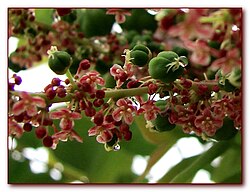Note: This is a project under development. The articles on this wiki are just being initiated and broadly incomplete. You can Help creating new pages.
Difference between revisions of "Phyllanthus acidus - Lavalīphala"
(→Identification) |
(→References) |
||
| Line 69: | Line 69: | ||
<references> | <references> | ||
<ref name="chemical composition">The Ayuredic Pharmacopoeia of India Part-1, Volume-5, Page no-14</ref> | <ref name="chemical composition">The Ayuredic Pharmacopoeia of India Part-1, Volume-5, Page no-14</ref> | ||
| − | <ref name="Leaf">[ "Morphology"]</ref> | + | <ref name="Leaf">[https://indiabiodiversity.org/species/show/266545 "Morphology"]</ref> |
<ref name="How to plant/cultivate">[http://tropical.theferns.info/viewtropical.php?id=Phyllanthus+acidus"Cultivation detail"]</ref> | <ref name="How to plant/cultivate">[http://tropical.theferns.info/viewtropical.php?id=Phyllanthus+acidus"Cultivation detail"]</ref> | ||
</references> | </references> | ||
Revision as of 15:54, 11 June 2019
Lavalīphala consists of dried fruit of Phyllanthus acidus (Linn.) Skeels syn. Cicca acida Linn. Merrill (Fam. Euphorbiaceae), a small or medium sized tree cultivated in gardens, and also grown as a roadside tree.
Contents
[hide]- 1 Uses
- 2 Parts Used
- 3 Chemical Composition
- 4 Common names
- 5 Properties
- 6 Habit
- 7 Identification
- 8 List of Ayurvedic medicine in which the herb is used
- 9 Where to get the saplings
- 10 Mode of Propagation
- 11 How to plant/cultivate
- 12 Commonly seen growing in areas
- 13 Photo Gallery
- 14 References
- 15 External Links
Uses
Asthma, Skin diseases, Itching, Fever, Urticaria, Bronchial catarrh, Eye-troubles.
Parts Used
Chemical Composition
Triterpenoids (β- amyrin, Phyllanthol) and Gallic acid.[1]
Common names
| Language | Common name |
|---|---|
| Kannada | |
| Hindi | Harfaarevadi, Lavali |
| Malayalam | |
| Tamil | Arinelli |
| Telugu | Raachayusarike |
| Marathi | NA |
| Gujarathi | NA |
| Punjabi | NA |
| Kashmiri | NA |
| Sanskrit | Sugandhamūlā, Lavalī, Komala Valkalā |
| English | Star gooseberry, Country gooseberry |
Properties
Reference: Dravya - Substance, Rasa - Taste, Guna - Qualities, Veerya - Potency, Vipaka - Post-digesion effect, Karma - Pharmacological activity, Prabhava - Therepeutics.
Dravya
Rasa
Kaṣāya, Amla, Madhura
Guna
Rūkṣa, Guru, Viśada
Veerya
Śīta
Vipaka
Madhura
Karma
Pittahara, Kaphahara, Vātakara, Grāhi, Rakta Stambhana
Prabhava
Habit
Identification
Leaf
| Kind | Shape | Feature |
|---|---|---|
| Simple | Alternate | The leaves are ovate or lanceolate in form, with short petioles and pointed ends about 2 to 7.5 cm long. They are green and smooth on the upper-side and blue-green on the underside. |
Flower
| Type | Size | Color and composition | Stamen | More information |
|---|---|---|---|---|
| Bisexual | pink | The flowers are small and pinkish and appear in clusters in 5 to 12.5 cm long panicles at leafless parts of the main branches, at the upper part of the tree. |
Fruit
| Type | Size | Mass | Appearance | Seeds | More information |
|---|---|---|---|---|---|
| Berry | The fruits are numerous, oblate, with 6 to 8 ribs, and are densely clustered. They are pale yellow or white, waxy, crisp, juicy and very sour. | About 4 to 6 seeds are contained in a stone at the center of each fruit |
Other features
List of Ayurvedic medicine in which the herb is used
Where to get the saplings
Mode of Propagation
Seeds, Greenwood cuttings, Budding, Air layering.
How to plant/cultivate
Gooseberry tree grows well in the tropics at low and medium altitudes in places with a short or prolonged dry season. It prefers hot, humid tropical lowlands. It flourishes from sea-level up to an altitude of 1,500 - 1,800 metres. Seed - easily germinated, it is the most common way of propagating the plant. Greenwood cuttings.[3]
Commonly seen growing in areas
Coastal forest, Dry limestone woodlands.
Photo Gallery
References
- Jump up ↑ The Ayuredic Pharmacopoeia of India Part-1, Volume-5, Page no-14
- Jump up ↑ "Morphology"
- Jump up ↑ "Cultivation detail"
External Links
- Ayurvedic Herbs known to be helpful to treat Asthma
- Ayurvedic Herbs known to be helpful to treat Skin diseases
- Ayurvedic Herbs known to be helpful to treat Itching
- Ayurvedic Herbs known to be helpful to treat Fever
- Ayurvedic Herbs known to be helpful to treat Urticaria
- Ayurvedic Herbs known to be helpful to treat Bronchial catarrh
- Ayurvedic Herbs known to be helpful to treat Eye-troubles
- Herbs with Fruits used in medicine
- Herbs with Flowers used in medicine
- Herbs with Leaves used in medicine
- Herbs with common name in Hindi
- Herbs with common name in Tamil
- Herbs with common name in Telugu
- Herbs with common name in Sanskrit
- Herbs with common name in English
- Habit - Deciduous tree
- Index of Plants which can be propagated by Seeds
- Index of Plants which can be propagated by Greenwood cuttings
- Index of Plants which can be propagated by Budding
- Index of Plants which can be propagated by Air layering
- Herbs that are commonly seen in the region of Coastal forest
- Herbs that are commonly seen in the region of Dry limestone woodlands
- Herbs
- Ayurvedic herbs that don't have seed photos
- Phyllanthaceae





